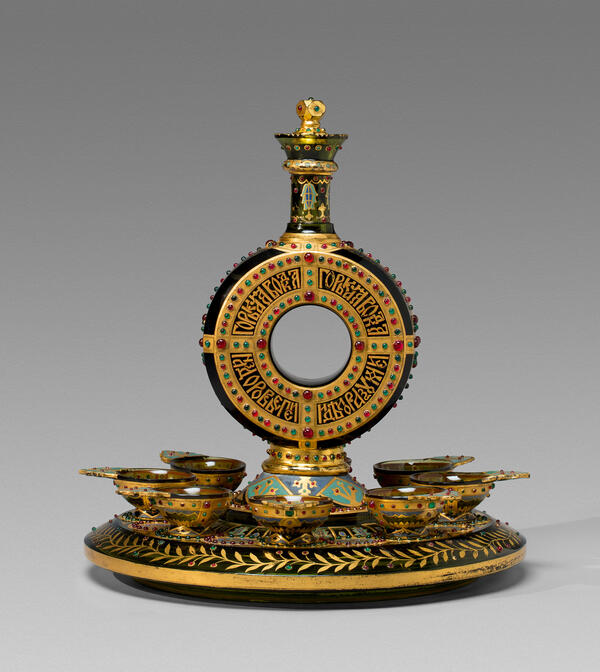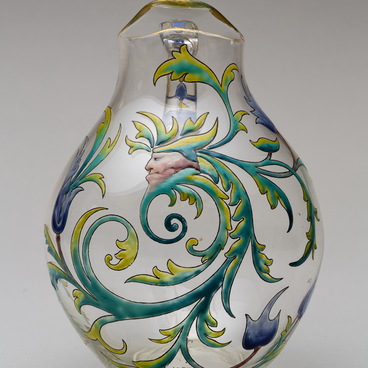The Imperial Glass Factory beverage set was designed by the famous architect Ippolit Monighetti. He was one of the most recognized architects of his time; he worked a lot on orders from the royal family and the highest aristocracy. Monighetti developed architectural projects in Moscow and St. Petersburg, including the construction of a graceful bathhouse in the form of a Turkish mosque in Tsarskoye Selo, drafting a building for the Polytechnic Museum in Moscow, and much more. Monighetti spent a long time in Italy, visited Greece and the East, studied architectural monuments, sketched their details and made a rich collection of sketches, which, upon his return to St. Petersburg in 1847, brought him the title of academician.
The beverage set presented in the exposition is one of the most vivid items of the Russian-Byzantine style in the museum’s collection. The development of the Russian-Byzantine style took place in the 1840s-1870s, when the theory of the official nationality was popular. Its motto — “Orthodoxy, autocracy, nationalism” — suggested turning not only to the Orthodox Russian-Byzantine heritage, but also to the state tradition of Ancient Rus. In his work, Monighetti focused on bright jewelry with gold and “stones”, inspired by the masters of Ancient Russia and Byzantium.
The set is made of dark green crystal in imitation of simple glass — the material from which such objects were created until the middle of the 18th century. The decanter was made in the form of a Russian kvass jug of the 17th — 18th centuries, which had a disc-shaped body with a hole in the center, and the cups looked like ladles with shelves-handles — products of Russian and Byzantine silversmiths. In addition, like the utensils of the 16th — 17th centuries with healthy inscriptions, the presented decanter is adorned with the folk proverb “Bitter vodka / drink for health and do your business”. A proverb, written in ornamental gold script, encircles the decanter’s body. The decanter is decorated with enamel and colored cabochon beads (smoothly polished), imitating precious stones.
Monighetti was a talented architect, and, in addition, he worked a lot on drawings and ornaments for artistic and industrial companies. He even gathered a group of students, whom he taught ornamental art.
The beverage set presented in the exposition is one of the most vivid items of the Russian-Byzantine style in the museum’s collection. The development of the Russian-Byzantine style took place in the 1840s-1870s, when the theory of the official nationality was popular. Its motto — “Orthodoxy, autocracy, nationalism” — suggested turning not only to the Orthodox Russian-Byzantine heritage, but also to the state tradition of Ancient Rus. In his work, Monighetti focused on bright jewelry with gold and “stones”, inspired by the masters of Ancient Russia and Byzantium.
The set is made of dark green crystal in imitation of simple glass — the material from which such objects were created until the middle of the 18th century. The decanter was made in the form of a Russian kvass jug of the 17th — 18th centuries, which had a disc-shaped body with a hole in the center, and the cups looked like ladles with shelves-handles — products of Russian and Byzantine silversmiths. In addition, like the utensils of the 16th — 17th centuries with healthy inscriptions, the presented decanter is adorned with the folk proverb “Bitter vodka / drink for health and do your business”. A proverb, written in ornamental gold script, encircles the decanter’s body. The decanter is decorated with enamel and colored cabochon beads (smoothly polished), imitating precious stones.
Monighetti was a talented architect, and, in addition, he worked a lot on drawings and ornaments for artistic and industrial companies. He even gathered a group of students, whom he taught ornamental art.



